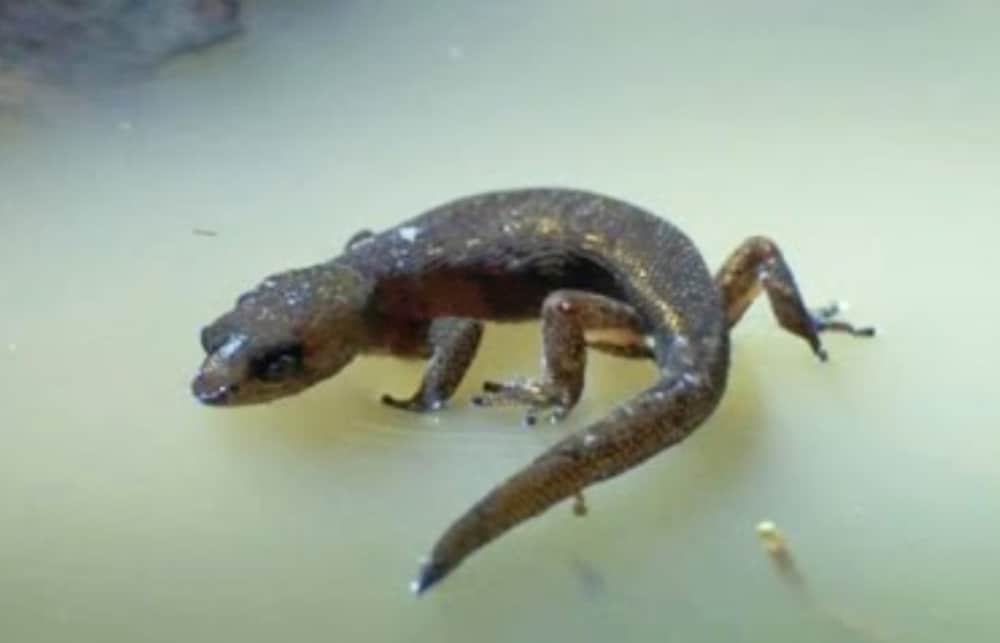Researchers dub geckos as superheroes. Outside of their amazing stunts on land and air, geckos can also run on water!

Geckos run on water by using these four factors — surface tension, water-slapping, hydrophobic skin, and body undulation. Aside from escaping predators, their ability to run on water inspires scientists to create future robots that can save lives.
For a deep dive on how geckos run on water, keep on reading!
How Geckos Run On Water — Explained
The principle behind the ability of geckos to run on water lies in these four factors.
Surface Tension
You may be familiar with surface tension. Surface tension commonly associates with insects walking on water like water striders. How can this even be possible?
As water stays at a resting state, water molecules stick together and form a bond forming surface tension. At this state, the surface acts like a stretched elastic membrane and holds light objects and insects, such as the water striders, without sinking.
Compared to light insects such as water striders, it wouldn’t seem that just water surface tension could hold the weight of geckos.
To prove that geckos indeed use water surface tension to stay on top of the water, researchers from the University of California performed an experiment.
To reduce the surface tension, researchers placed a soap formula in water. The soap contains carbon and hydrogen atoms that break binding water molecules forming surface tension. The presence of soap made the body of geckos sink in half, and its speed slowed down to 58 percent. The experiment proved geckos exploit surface tension to stay afloat on the surface.
Water-Slapping Technique
By the use of their four legs, geckos slap the water underneath their foot to rocket forward. We can see a similar technique done by basilisk lizards — commonly known as the Jesus Christ lizard.
The water-slapping technique involves three processes. First, they raise their foot in the air, slap the water and then stroke the water underneath. As they kick their feet down, air cavities form. Air cavities refer to air pouches formed around their feet as they kick the water downward. As the feet push down the air pouches, it creates an upward force that keeps the gecko on top of the water surface until it takes another step.
Smaller insects use surface tension to stay afloat while moving on the surface. On the other hand, large animals like the basilisk lizard have to use muscle strength to accomplish the same. Interestingly enough, geckos use both surface tension and water-slapping to stay on the water’s surface while running.
Hydrophobic Skin and Body Undulation
Aside from surface tension and water-slapping technique, geckos acquire a hydrophobic skin that aids in propelling them forward without sinking in. Hydrophobic skin means it can repel water and prevent its formation on the skin.
The hydrophobic skin of geckos comprises spinules or tiny spines that cover the epidermis. These spinules prevent water from staying in the skin by turning the water into droplets. Once these droplets accumulate and turn into big water drops, the skin pushes them off.
Geckos also do undulation as they run on water. They do this by moving their tail and body in a wave-like movement similar to swimming alligators. During undulation, they integrate swimming while they run on water. This means geckos do half-running and half-swimming at the same time.
How Fast Do Geckos Run On Water?
Geckos can run on water at a speed of three feet per second. They run as fast on the water as they do on land. Researchers say that geckos can run faster than other aquatic animals such as marine iguanas, juvenile alligators and even ducks.
What Species of Geckos Can Run On Water?
Asian House Geckos
Running on water behavior was first observed in the Asian house geckos. Researchers collected and used the same species of geckos in the experiment. Asian house geckos are also known as wall geckos, pacific house geckos, moon lizard or house lizard from the species of Hemidactylus frenatus.

Pygmy Geckos
On the other hand, the pygmy gecko not only runs on water, but it can also walk or float and relax on the water. When the rain is pouring hard, these geckos don’t fear water because they can float. Thanks to their superhydrophobic skin and light weight that allows surface tension to keep them suspended for as long as they like.

As a great supplement to the “how they do it” also check out the videos below that show some videos and further explains this amazing ability.
Do Geckos Like Being On Water?
Not all geckos like being on water. For example, leopard geckos hate being on water. They live in warm and dry areas in the wild and avoid wet environments. If you own a pet gecko, it is important to look after its health. Forcing your geckos to stay on water can cause stress and lead to serious health problems such as sleep dysfunction and heart disease.
Do Geckos Drown?
Geckos can’t breathe when they sink underwater. Just like humans, they need air to breathe. Lizards such as geckos, in general, belong to the reptile family. Reptiles can’t breathe underwater, so when they sink in water, they drown.
Can Geckos Swim?
Although running, walking and swimming differ, some people use these terms interchangeably when they describe the geckos’ locomotive strategy on water. Some geckos can’t run, but instead, they swim. Others can walk on water like the pygmy gecko.
Maybe you’re wondering if all geckos can swim on water. All geckos can swim — if they really need to.
Before you toss your pet geckos on water, remember that geckos don’t like swimming. They may swim but it doesn’t mean they like it. They only swim in cases where they have no other option such as escaping a predator — or when you push them in water.
Geckos That Don’t Like Swimming
Geckos don’t swim for pleasure. They only do it as a survival tactic. If ever you have the following pets mentioned below, don’t try to force them to swim on water. It will be stressful for them.
- Leopard Geckos
- Crested Geckos
- Madagascar Day Geckos
- White-Lined Geckos
- African fat-tailed Geckos
- Frog Eyed Gecko
- Gargoyle Gecko
Geckos As Models for the Future’s Robots
Geckos’ propulsion on water inspires future research in building robots for search and rescue operations in areas with floods.
Currently, basilisk lizards inspired a concept of a bipedal running robot in water. Researchers plan to integrate the gecko’s undulating tail and hydroplaning ability on the water. They foresee that mixing these mechanisms could improve the future robot’s stability, velocity and energy efficiency.
In fact, Israel already made a robot called the amphiSTAR inspired by the basilisk lizards that aims to be of use in search and rescue missions, agriculture and excavations. Aside from the basilisk lizard, the robot gets inspiration from the movements of cockroaches to sprawl. A team of scientists from Ben-Gurion University of Negev led the innovation.
Conclusion
As a summary, geckos run on water with the influence of surface tension. Without it, the geckos’ flounder and their speed reduces to almost half. Aside from surface tension, geckos also slap water using their four legs. This movement allows them to move forward without sinking. The hydrophobic skin of geckos repel water and aid them in hydroplaning forward. Geckos also undulate their body and tail as they sprint over water.
Not all geckos run on water, some swim. Geckos only swim when the circumstances demand it. They don’t like being on water. It’s not a good idea to force your geckos to swim as they are not built for swimming. They only swim for survival reasons.
Scientists envision making a robot based on the geckos’ movement mechanism on the water as it promises very efficient machines that perform life-saving aids such as rescue missions in areas with floods. This vision slowly comes to life in Israel, which has already created a robot with the same objectives.
